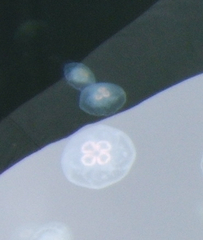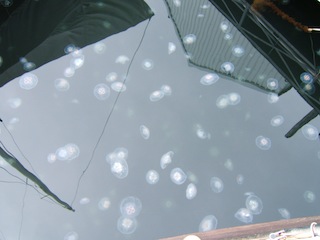Aurelia labiata
From marinelife1011
| Aurelia labiata | |
|---|---|
[[file: |frameless|alt=]] |frameless|alt=]] |
|
| Mature medusae, West Bay Marina, Olympia, Wa, USA. The middle medusa has an irregular number of gonads. | |
| Scientific classification | |
| Kingdom: | Animalia |
| Phylum: | Cnidaria |
| Subphylum: | Medusozoa |
| Class: | Scyphozoa |
| Order: | Semaeostomeae |
| Family: | Ulmaridae |
| Genus: | Aurelia |
| Species: | labiata |
| Synonyms | |
|
Moon Jellyfish |
|
Commonly known as the Moon Jellyfish, the genus of Aurelia is found in oceanic waters worldwide. The species of A. labiata is found along the coast of the Pacific Northwest, Alaska and California.
Description: The gelatinous zooplankton A. labiata is characterized by a translucent umbrella shaped medusa of 5 cm to 40 cm across with four visible horseshoe shaped gonads that range in color (pink, yellow or purple). The medusa decreases in thickness from the middle to the outer edge. A. labiata has limited movement produced by pulsations of the bell, but mainly relies on currents for transport. There is a fringe of tentacles surrounding the bell for capturing prey and oral tentacles within the bell that break down food and transport it to the oral cavity. A. labiata prey on copepods, small fish, ctenophores and other jellyfish.
Habitat: A. labiata is a pelagic scyphozoa that can be found in coastal and inland waters ranging from southern Alaska to southern California, USA in depths of 0-15m. A. labiata survive in waters ranging in temperature form 8°C to 21°C.
Life History: Two mature (male and female) medusae reproduce sexually in the water column to produce a planula that settles on a shaded benthic region to develop in to a polyp. Polyps reproduce asexually to release small ephyra into the water column.
Environmental Impact: Dense aggregations of A. labiata have been linked to increased nutrient runoff of anthropogenic origin. Jellyfish blooms credited to eutrification affect the composition of zooplankton, as well as, larger organisms in the water column. There is increasing concern that commercially important fisheries are being affected and will be further threatened due to lack of available bait fish and increased jellyfish populations.
Aurelia Aggregation: This aggregation of A. labiata was photographed in West Bay Marina, Olympia, Wa, USA on 10 April 2005 following flooding events that occurred that winter.
Sources:
Arai, MN, Pelagic coelenterates and eutrophication: a review, Hydrobiologia [Hydrobiologia]. Vol. 451, no. 1-3, pp. 69-87. May 2001.
Brown, E. et al, Aggregations of the jellyfish Aurelia labiata: abundance, distribution, association with age-0 walleye pollock, and behaviors promoting aggregation in Prince William Sound, Alaska, USA, Marine ecological Progress Series, 2000.
Hanby, Bernard P. and Andy Lamb. Marine Life of the Pacific Northwest: A photographic Encyclopedia of Invertebrates, Seaweeds and Selected Fishes. Harbour Publishing.
Lucas, Cathy. Reproduction and life history strategies of the common jellyfish, Aurelia aurita, in relation to its ambient environment, Hydrobiologia, 229.246, 2001.
Purcell, Jennifer E, Environmental effects on asexual reproduction rates of the scyphozoan Aurelia labiata, Marine Ecology Progress Series [Mar. Ecol. Prog. Ser.]. Vol. 348, pp. 183-196. Oct 2007.

